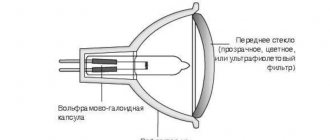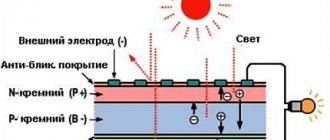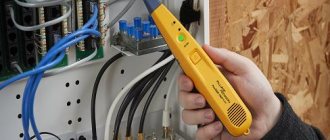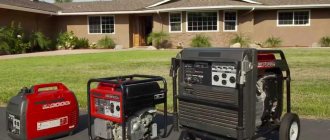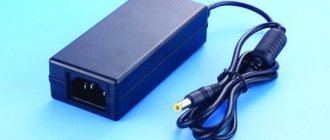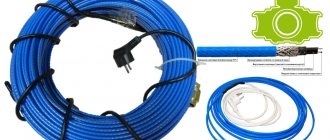Photo: prorabtools.ru
Power outages, unfortunately, are not uncommon these days. If this happens once every six months and lasts about half an hour, they may not cause too much inconvenience. But when, on average, two or three times a month you are forced to arrange a candlelit evening, the situation becomes not at all rosy. There is no lighting, the refrigerator is defrosting, the boiler is not working... This means that you need your own generator for your home. And this can no longer be called just a whim or a desire for increased comfort. This is an adequate assessment of the situation, a way to solve the problem. Of course, we cannot say that a generator is vital for everyone, but in many cases it will help you easily get rid of some unpleasant moments. At the same time, a purchase decision most often comes with a huge number of questions: it is not clear where to start, how to choose from the huge number of offered equipment models exactly the one that will be the ideal option for the task at hand.
Let's start by defining goals
When choosing a generator, the first question that will need to be answered is: “What is the purpose of using it?” Such equipment can serve as the main source of energy. This is necessary if connecting to a centralized power supply network is impossible or does not make sense (for example, at a dacha, at temporary construction sites). But most often, a mini-power plant is used as a reserve in case of an emergency in the main power supply system. When choosing a generator as the main power source, the basis will be such characteristics of the unit as its
- sufficient power,
- relatively long motor life,
- efficiency,
- reliability,
- the presence of an extensive service network,
- compactness and weight (if frequent transportation is necessary),
- ease of use.
In this case, convenience is no less important than, for example, the reliability of the equipment. Few people would like to run to the generator every 3-4 hours around the clock to top up fuel or repair it after six months, leaving the house without electricity. As for efficiency, fuel consumption and cost always become one of the determining factors when choosing any equipment. Finally, the power of the unit must be selected so that consumers do not think about what is currently plugged into the outlet and what else can be turned on without overloading the generator. Most often, a power plant is still required as a backup power source, so we will dwell in more detail on this option.
How to count?
In order to correctly calculate the power and prevent the mobile power station from breaking down during operation, it is important to take into account every electrical appliance in the house, as well as think through all possible situations that may arise.
Thus, the preparatory stage is a complete accounting of all electrical appliances in the house. In order to conduct an inventory, you need:
2. Write down the electrical equipment used in the house. In this case, it is important to write the name of the device, and next to it - its power in kilowatts.
3. Write down the electrical equipment that you plan to purchase and use in the future.
After this, you will need to calculate the total power of the electrical appliances in use. During the inventory process, it is important to understand which electrical appliances are vital, and which ones will be used extremely rarely, and can be forgotten about during a power outage.
For example, lights and a refrigerator will be needed in the event of a power outage. The same can be said about the stove and kettle. Telephones, computers and other similar devices are no longer so important, so they can be classified as the second group of necessary devices.
The third group - the least necessary electrical appliances - consists of a vacuum cleaner, washing machine, iron and similar devices. It’s unlikely that anyone would want to suddenly go clean the carpet when the electricity suddenly goes out.
What power generator should I choose for my home or cottage?
Approximate calculations will not work in this case, so it is worth paying special attention to this point. The principle is quite simple: it is necessary to add up the power of all individual electrical consumers that must be included in the network at the same time. All the necessary data can be found on labels, nameplates or in the equipment instructions. You can refer to the data provided by the manufacturers (on the Internet today you can find instructions for almost any model of equipment or tool). It is very important to pay attention to the fact that it is necessary to add power values not in the usual kW, but in kVA (kilovolt-amperes). For reference: the total power of the equipment is measured in kVA, which includes the sum of its active (kW) and reactive (kVAr) components. Depending on the operating characteristics of a particular electrical consumer, their ratio may differ significantly from each other, so calculations are made in this way. Also, when determining power, starting currents are of great importance, which for some types of equipment can exceed the rated values by 3-6 times. Starting current is the current consumed by the motor from the mains when starting (i.e. when the device is turned on). So, for example, if you have a pumping station, you should include in the calculations the power of the unit, multiplied by a factor of 3.5-4 (depending on the specific model). The same situation will happen with a refrigerator, air conditioner, and washing machine. To the resulting figure, it is necessary to add a 20-30% power reserve, which will allow the generator to operate in its optimal mode even if all intended consumers are included in the network. Then the nearest larger value is selected from the standard series of generator powers. The issue is resolved.
Photo: www.vseinstrumenti.ru
In most cases, if it is necessary to connect a minimum number of consumers (several light bulbs, a TV and a refrigerator), a gasoline generator with a power of 2-3 kW is chosen. If, for example, you have a workshop at home and require power for several tools, you will need a unit of 6 kW or more. If you frequently use a welding machine, the optimal solution would be to purchase a specialized welding generator.
What can be connected simultaneously at 4 kilowatts?
I had a similar question “what can be connected to 4 kilowatts at the same time” when I purchased an AC gas generator for the taiga winter hut and for my relatives’ dacha, which was then still under construction. For apartment wiring, this question rarely arises, because the power removed from household outlets is most often dictated by the amperage of the circuit breakers. But for this case, our answers to this question will also be relevant.
So, a lot depends on the maximum power value indicated in the technical documentation (certificate plate) for the connected consumer. Here we simply arithmetically sum up all the powers of our partings until we reach 4 kilowatts (4000 Watts)
Here is a list of average power of major household consumers. But it’s still worth checking the passport data of your devices (if this data is available).
- Electric oven – 17,221 watts
- Central air conditioning – 5000 watts
- Tumble dryer - 3400 watts
- Electric oven – 2300 watts
- Dishwasher – 1800 watts
- Hair dryer – 1538 watt
- Heater – 1500 watt
- Coffee maker – 1500 watt
- Microwave – 1500 watts
- Popcorn maker – 1400 watt
- Toaster oven (ovens toaster) – 1200 watts
- Iron – 1100 watt
- Toaster – 1100 watts
- Room air conditioner – 1000 watt
- Electric cooker – 1000 watts
- Vacuum cleaner – 650 watt
- Water heater – 479 watts
- Washing machine – 425 watt
- Espresso coffee maker (espresso machine) – 360 watts
- Dehumidifier – 350 watt
- Plasma TV - 339 watts
- Blender – 300 watt
- Freezer - 273 watts
- Liquid crystal TV (LCD) – 213 watts
- Game console – 195 watts
- Refrigerator – 188 watts
- Regular TV (Cathode Ray Tube) – 150 watts
- Monitor – 150 watts
- Computer (power supply) – 120 watts
- Portable Fan – 100W
- Electric blanket – 100 W
- Stand mixer – 100 W
- Electric can opener – 100 W
- Hair curling iron – 90 W
- Ceiling Fan – 75 W
- Humidifier – 75 W
- Incandescent lamp (60-watt) – 60 W
- Stereo system - 60 W
- Laptop – 50 W
- Printer – 45 W
- Digital Video Recorder (DVR) – 33 W
- Aquarium – 30 W
- Cable Box – 20 W
- Compact fluorescent lamp (energy saving lamp), equivalent to 60 W – 18 W
- DVD player – 17 W
- Satellite dish – 15 W
- VCR – 11 W
- Clock Radio – 10 W
- Portable stereo system (boombox) – 7 W
- Wireless Wi-Fi Router – 7 W
- Mobile phone charger – 4 W
- Cordless phone – 3 W
- Autoresponder – 1 W
And of course, I would like to say separately everything about the same gas generator (diesel generator)
The fact is that when purchasing an autonomous generator, you should understand that the declared (usually advertised) power is peak power and it cannot produce it for a long time. From this, as a rule, the “upper” power value, feel free to subtract 20% and get the value of the continuous load at which the unit will operate normally and will not be overloaded.
Another point - keep in mind that the starting currents of motors can be 5-10 times higher than operating currents. This, albeit short-term, is still by no means a small additional load and voltage drop.
What can be connected to a low power generator?
Low-power generators (0.5-2 kW) are in greatest demand due to their relatively low cost, as well as the ability to connect a minimum list of consumers that require high reliability in power supply. With this choice for a home, the first place most often comes from connecting lighting (on average about 6 lamps), a heating boiler, and household appliances (refrigerator, iron, TV).
| 0.5 kW | 1-2 light bulbs, phone charger, laptop/light bulb and TV |
| 1 kW | 2-3 light bulbs, laptop, phone charger/refrigerator and 1-2 light bulbs/1-2 light bulbs and heating boiler (stabilizer required) |
| 2 kW | 3-4 light bulbs, boiler, laptop, refrigerator, phone charger, TV |
Rating of TOP 10 best models
| Place | Name | Price |
| TOP 10 best 3 kW gasoline generators | ||
| 1 | BISON ZIG-3500 | 37 000 ₽ |
| 2 | Huter DY4000L | 17 000 ₽ |
| 3 | Huter DY4000LX | 21 000 ₽ |
| 4 | BISON ZESB-3500 | 21 000 ₽ |
| 5 | Fubag BS 3300 ES | 24 000 ₽ |
| 6 | Fubag BS 3300 (838753) | 19 000 ₽ |
| 7 | Eurolux G4000A | 12 000 ₽ |
| 8 | PATRIOT GP 3000iL | 40 000 ₽ |
| 9 | BISON ZESB-3500-EM2 | 25 000 ₽ |
| 10 | Sturm! PG8735 | 18 000 ₽ |
Petrol, diesel or gas?
One of the fundamental points in choosing a generator, which follows from the previously obtained power value, is the type of fuel used in the operation. There are only two clear situations in this case:
- if you need a generator with a power of up to 2-3 kW, in this case you need a gasoline model,
- if the equipment power is more than 15 kW, then diesel is your option.
For both situations, there is only one explanation: electric generators running on other types of fuel are not produced.
As for intermediate indicators, everything is a little more complicated. Often the cost of the equipment and its subsequent operation, as well as the features of its future application, are decisive.
Gasoline generators
Photo: invertor-generator ru Petrol generator FUBAG BS 1100
The main characteristics of such equipment are
- compactness,
- ease of transportation,
- low cost mini power plant,
- low noise level,
- higher fuel costs,
- resource from 500 to 3000 hours (depending on model and brand).
This option is perfect for situations where constant transportation of the power plant is required; its switching on occurs rarely and for a short time.
Separately, I would like to draw attention to the value of the “motor resource” indicator when choosing equipment. This figure indicates the number of hours after which the equipment must undergo scheduled comprehensive maintenance. Simply put, the number of engine hours is the average duration of operation of the generator between repairs according to testing data of the selected model by the manufacturer.
Inverter generators
Photo: www.toool.ru Inverter gas generator HUTER DN2700
Inverter-type gasoline generators are one of the best options when choosing equipment in this class. They differ from traditionally designed equipment by the presence of an engine speed controller and an electronic ignition system. At the same time, the efficiency of such units is due to the fact that the number of revolutions changes depending on the load, which allows for significant fuel savings. As a result, the electronics completely control the level of generated voltage.
Diesel generators
Photo: www.ers-energo.ru Diesel generator SDMO DIESEL 4000 E
In this case, there is a choice between a stationary and portable installation (in other words, between a water-cooled and an air-cooled power plant). Air diesel generators are great for frequent power problems as a backup. They have a service life of about 4000 hours, are economical to operate and can withstand more intense operating conditions compared to their gasoline counterparts.
If all the benefits of civilization are far away and there is a high probability that problems with power supply can arise at any moment and last for an unknown amount of time, a stationary water-cooled diesel generator is what you need. To say they are reliable is an understatement. They can work around the clock, and the service life is 40,000 hours. Another feature of them is their weight (most often it is about 200-250 kg), although this can also have its “plus”: it will be very difficult to steal such a generator even with a strong desire difficult.
Gas generators
Photo: www.toool.ru Gas generator KIPOR KNE5500E
Recently, gas generators have become a worthy (though not yet very widespread) alternative to units running on gasoline or diesel. Its main advantages can be called
- low cost of fuel (it is also very convenient that there is no need to monitor the fuel level in the tank, especially when the generator runs on natural gas);
- high efficiency;
- low noise level;
- environmental friendliness.
Flaws
- high cost of equipment;
- the difficulty of transporting liquefied gas (in the absence of a source of natural fuel);
- complex safety measures during operation;
- difficulty connecting to the main line;
- connection requires specialists with experience in performing such work.
The best 3 kW gasoline generators
BISON ZIG-3500
This is a powerful, silent, inverter, synchronous gas generator . Suitable for supplying retail facilities, partial
energy supply of a private or country house.
Equipped with a special economical mode, which reduces fuel consumption when the unit is not fully loaded.
There is a protective automatic engine shutdown when the oil level is low.
The generator is equipped with a full-fledged four-stroke single-cylinder engine, which is easy to operate, has a long service life, is economical and environmentally friendly.
Characteristics:
- launch type - manual;
- voltage - 220 V;
- engine volume - 149 cubic meters. cm, power - 5.7 l. With.;
- tank volume - 5.7 l;
- active power - 3 kW, maximum - 3.5 kW;
- sockets - 2 for 220 V, 1 for 12 V;
- weight - 30 kg.
Advantages:
- effective overload protection;
- air cooling;
- Autonomous operation for 3.1 hours;
- built-in indicators;
- mobility;
- quiet work.
Huter DY4000L
Synchronous petrol generator with manual start based on the Huter 170F engine . You can use gas instead of gasoline. Unit
supplies electricity to household appliances, gadgets, professional equipment, and power tools.
Thanks to the protection and control system, safe operation and stable, high-quality output voltage are observed.
The generator belongs to the family of mini-power plants . Their design was developed by German engineers using modern stands.
The products were able to fully satisfy the needs of users.
Characteristics:
- voltage - 220 V;
- engine type - single-cylinder, four-stroke, power - 7 liters. With.;
- fuel consumption - 395 g/h;
- tank volume - 15 l;
- active power - 3 kW;
- sockets - 1 for 220 V;
- dimensions - 60.5x43.5x45 cm;
- weight - 45 kg.
One or three phases?
This question is as important as the previous ones, because a single-phase and three-phase generator are completely different devices that have their own conditions for operation and application. There is simply no answer to the question of which is better. Each individual situation has its own variant.
Photo: donelektrik.ru Single-phase network diagram
- If there is not a single three-phase consumer in the house and the centralized power supply is supplied through one line, the conclusion is clear: a single-phase generator is needed.
- A single-phase unit is also needed when three lines are connected, but only one needs to be reserved (if, for example, a heating system, refrigerator, pumping station, etc. is connected to it).
- If you have single- and three-phase consumers, you can go in two ways: buy two power plants of different designs or still one three-phase, but be sure to ensure that the loads between the lines are distributed evenly.
Photo: donelektrik.ru Three-phase network diagram
If 3 phases , there are also two options:
- Buy a 3-phase power plant and a 3-phase automatic transfer switch (automatically entering a reserve, which will automatically turn on the generator when the power in the centralized network disappears). In this case, it is necessary to lay separate lines in which a uniform distribution of loads between them would be provided, and their sum would not be more than a third of the total power of the unit (if the generator is designed for 15 kW, not more than 5 kW).
- 1-phase generator and 3-phase ATS in the absence of three-phase consumers. In this case, if necessary, the automation will connect all the phases of the network with the generator, and the unit will simultaneously power each of them. At the same time, you no longer have to worry about ensuring that the loads are evenly distributed.
It is important to consider when connecting a three-phase unit to the network that the maximum permissible phase imbalance is 25% of the power. If this rule is not followed, the generator will simply fail.
Watt, kilowatt and kilowatt-hour
The unit of measurement watt got its name in honor of the scientist James Watt, who studied electricity in the nineteenth century. It is he who is credited with the invention of the universal steam engine.
Today, any power is measured in watts, not just electrical power. For example, to measure the power of a car engine, watts are also used along with horsepower. However, most often it is not the “watt” itself that is used, but its derivative, the kilowatt (kW). By analogy with the meter and kilometer, as well as with the gram and kilogram, one kilowatt is equal to a thousand watts.
Energy is often also calculated in other units, multiples of the watt. For example, to measure high power it is convenient to use the megawatt, a unit that corresponds to a million watts. You can also use other prefixes of the international system of units, including those that correspond to tenths, hundredths, thousandths.
For example:
- deciwatt is a tenth of a watt;
- centiwatt - its hundredth part;
- A milliwatt is a thousandth of a watt.
The electric power that is consumed by ordinary household appliances such as lamps, refrigerators, and TVs is best measured in kW. If the watt and its derivative units are included in the SI system, then the kilowatt-hour is not there. KWh is a unit of measurement that is non-systemic. It was created only to keep track of the electrical energy produced or, conversely, used.
The use of kWh on the territory of the Russian Federation is regulated by GOST, which clearly indicates the name, designation and area in which it is used. A kilowatt-hour can be designated either by four Russian letters or three English ones. The Russian designation is “kWh”, and the English designation is “kW h”.
You may be interested in this. Designation of the unit of measurement W (watt)
Device management options
- Manual start. This type of starting is most often used in low-power generators. In order to start the unit, you will need to strongly pull the cord/twist the handle/press the starter pedal. It must be admitted that this is quite inconvenient and will require considerable physical effort.
- Electric start. With this design, to start it will be enough to simply press a button on the panel.
- Autostart. In this case, when the mains power goes out, the generator will start automatically without operator intervention, and then turn off when power is restored with a set time delay. The only thing that needs to be taken into account for this version is that the automation will not work if the temperature is less than +5 ˚С, so it is necessary to either install the equipment in a heated container or in a heated room.
Generator fuel consumption
Regardless of the type of equipment, fuel consumption directly depends on:
- from the load connected to the unit,
- efficiency of a specific model,
- fuel quality,
- clogged oil and fuel filters.
On average, a gasoline unit can consume 0.3÷0.45 kg/kWh, and a diesel unit 0.184÷0.220 kg/kWh.
Photo: www.elitech-tools.ru
Electric generator maintenance
In order for the generator to operate reliably and efficiently for a long time, maintenance is necessary. All activities that are required to be carried out, as well as their frequency, are always prescribed in the manufacturer’s operating instructions. The scope of such work largely depends on the brand of equipment, its features, its components and their quality.
On average, the maintenance frequency is 250-300 engine hours. At the same time, it is important to periodically check the condition of oil, air and fuel filters, oil, ventilation systems, belt tension, etc. If necessary, the elements are cleaned or replaced.
Popular manufacturers
Choosing a brand of equipment is one of the most important tasks. Among the most popular are
- Honda , which is distinguished by high and stable production quality, as well as the ability to select equipment for difficult working conditions, low noise levels, easy starting, good traction and power performance.
- Kipor is one of the highly reliable Chinese brands with a large range of gasoline and diesel units, which is in demand due to its relatively low cost and is perfect for use at home or in the country.
- Huter is a brand that appeared on the Russian market relatively recently and is distinguished by its low cost, reliability and stability, and a wide range of models, including gas units.
- Zubr is a Belarusian brand that is on par with the world's leading brands at an optimal price level.
Hyundai , SDMO , Wilson , DDE and FUBAG are also widely represented on the market . It is also worth paying attention when choosing a specific model and manufacturer to the availability of a developed network of technical service centers for this equipment in order to protect yourself from lengthy searches for the necessary specialists and spare parts.
Selection rules
Today, manufacturers offer a choice of different types of generators with different dimensions and power. Some of them are able to provide the required amount of electricity to appliances in the house, others can produce energy for the whole house.
There are several rules for choosing a mobile power station. When purchasing, you should pay attention to the following criteria:
1. Phase type. Most household appliances operate on voltage, the frequency of which reaches 50 Hz, and the power does not exceed 220 V. The appliances require an appropriate generator, and single-phase models are usually suitable. In cases when it comes to choosing a station to provide electricity to a house or site, as well as in cases where it is necessary to use additional equipment, it is worth giving preference to three-phase models of units.
2. Noise. Almost everyone knows that a generator makes a lot of noise during operation. Therefore, even installing the unit in a garage or utility room cannot eliminate the unpleasant sound of the station being used. In this case, a generator with a protective casing can help, which will create additional sound insulation and reduce the noise level.
3. Power. One of the main indicators that you should pay attention to when choosing a generator. To select a suitable power plant, it is necessary to calculate the required power.
4. Manufacturer. Today, the number of manufacturers offering their generators is growing inexorably. Therefore, it is worth carefully studying the characteristics of each model of mobile power plant and focusing on better ones.
5. Voltage quality. This parameter is most developed in inverter gasoline generators. The difference between such a unit is the possibility of transforming the electric current, as well as stabilizing it. Thus, the generator protects sensitive devices.
6. Housing type. If you need to choose a compact model, then preference can be given to a gasoline generator, the design of which provides autostart and noise reduction. This model is built into a block or suitable container.
Experts also recommend that you familiarize yourself with the type of engine being used in advance. For example, two-stroke motors are suitable for providing electricity to electrical appliances. If long-term operation of the device is required, then it is better to choose four-stroke ones.

